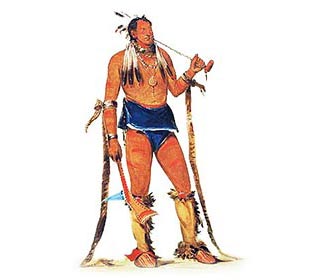Fast Facts about the History of Wisconsin Indians
The climate, land, history, environment and natural resources that were available to the indigenous Indian tribes in Wisconsin resulted in the adoption of the Northeast Woodlands culture. - Name of State: Wisconsin
- Meaning of State name: Named after the Wisconsin River and means "grassy place" in the Chippewa language
- Geography, Environment and Characteristics of the State of Wisconsin: Lake Superior lowland and highland sloping to the sandy central plain
- Culture adopted by Wisconsin Indians: Northeast Woodlands Cultural Group
- Languages: Iroquoian and Algonquian
- Way of Life (Lifestyle): Hunter-gatherers, farmers, fishers, trappers
- Types of housing, homes or shelters: Chickees, Wigwams (aka Birchbark houses) and Longhouses
History Timeline of the Wisconsin Indians - 10,000 B.C.: Paleo-Indian Era (Stone Age culture) the earliest human inhabitants of America who lived in caves and were Nomadic hunters of large game including the Great Mammoth and giant bison.
- 7000 BC: Archaic Period in which people built basic shelters and made stone weapons and stone tools
- 1000 AD: Woodland Period including the Hopewell cultures established along rivers in the Northeastern and Midwestern United States which included trade exchange systems and burial systems
- 1000: Mississippian Culture established. This was the last of the mound-building cultures of North America in Midwestern, Eastern, and Southeastern United States
- 1634: Jean Nicolet was the first known European to reach Wisconsin in search of the Northwest Passage.
- 1679: Frenchman Daniel Greysolon, Sieur du Luth (1636–1710) claims the region for France
- 1775: 1775 - 1783 - The American Revolution.
- 1776: July 4, 1776 - United States Declaration of Independence
- 1803: The United States bought the Louisiana Territory from France for 15 million dollars for the land
- 1812: 1812 - 1815: The War of 1812 between U.S. and Great Britain, ended in a stalemate but confirmed America's Independence
- 1830: Indian Removal Act
- 1832: Department of Indian Affairs established
- 1832: Black Hawk War occurred in Northern Illinois, Michigan, Southwestern Wisconsin including the Battle of Bad Axe - see Black Hawk
- 1861: 1861 - 1865: The American Civil War.
- 1862: U.S. Congress passes Homestead Act opening the Great Plains to settlers
- 1865: The surrender of Robert E. Lee on April 9 1865 signalled the end of the Confederacy
- 1887: Dawes General Allotment Act passed by Congress leads to the break up of the large Indian Reservations and the sale of Indian lands to white settlers
- 1969: All Indians declared citizens of U.S.
- 1979: American Indian Religious Freedom Act was passed
History of Wisconsin Indians - Destruction and Decline
The history of the European invasion brought epidemic diseases such as tuberculosis, cholera, influenza, measles and smallpox. The Native Indians of Wisconsin had not developed immunities against these diseases resulting in huge losses in population. Exploitation including the leverage of taxes, enforced labor and enslavement were part of their history, taking their toll on the Wisconsin Indians. |
